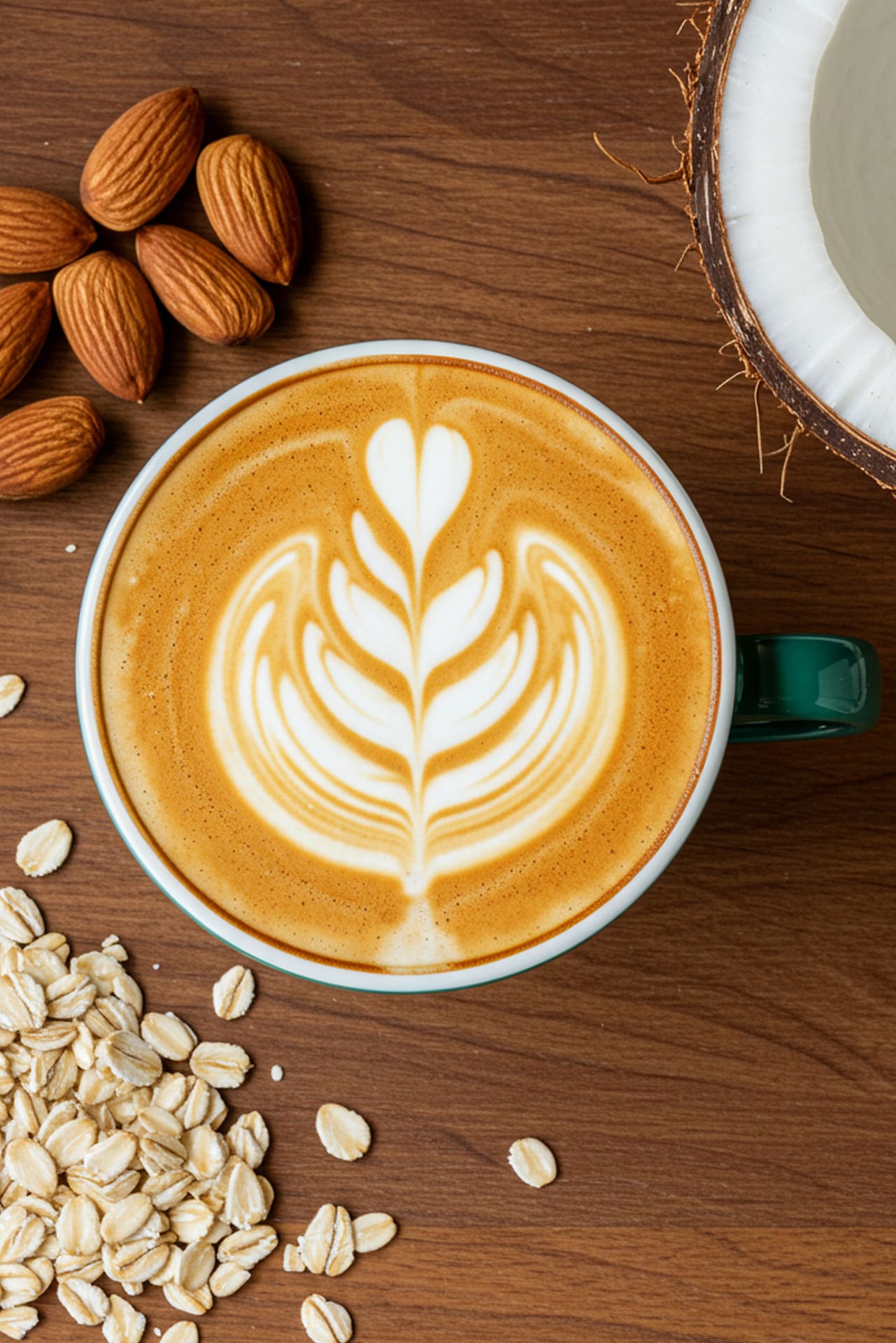Younger people are drinking plant-based milk 550% more than before. This change is big in the coffee world. The market for plant-based milk is now worth $21 billion.
Coffee shops, from small local places to big chains like Starbucks, are working hard to keep up. More than 50% of U.S. coffee shops now offer almond, oat, or soy milk. And 60% of millennials choose these over dairy milk.

This isn’t just a passing trend. It’s a big change. People are choosing plant-based milk for its taste, because it’s better for the planet, and for their health.
Key Takeaways
- Plant-based milk sales hit $21 billion globally in 2021.
- 50% of U.S. coffee shops now serve plant-based milk options.
- Millennials prefer plant-based milk in coffee 60% of the time.
- Oat milk sales jumped 300% between 2019 and 2021.
- 70% of drinkers say plant-based milk tastes as good or better than dairy.
Introduction
Traditional dairy milk use has fallen 42% in 50 years. But plant-based options are growing fast. Now, oat milk is more popular than almond milk in places like New York. Cafés see dairy-free coffee as a big hit, not just for a few.
- Health: Options like oat and soy milk often add vitamins and minerals, appealing to health-conscious drinkers.
- Planet: Oat milk uses 13x less water than dairy milk, aligning with eco-conscious choices.
- Flexibility: Whether avoiding lactose or seeking variety, dairy-free coffee caters to diverse needs.
From Oatly’s 2017 U.S. launch to brands like Ghost Town Oats leading the way, innovation is changing café menus. As we dive into this trend, we’ll see why plant based is now the norm in coffee culture.
Why Plant-Based Milks Are Gaining Popularity
More coffee lovers are choosing plant-based milks over dairy. They care about health, the planet, and personal needs. Let’s explore why plant-based coffee is becoming the favorite.
“49% of Gen Z admit they feel embarrassed to order dairy in public, with 57% planning to quit it entirely.”
Health Benefits
Vegan and dairy-free coffee are popular for their clean ingredients. Oat milk has fiber, almond milk is low in calories, and soy milk has protein. These qualities attract health-conscious drinkers who want to avoid dairy hormones.
Environmental Impact
Switching to plant-based coffee reduces emissions. One non-dairy latte cuts 0.143kg CO2. Starbucks says dairy causes 21% of their emissions, more than packaging or waste.
Almond milk uses 12L of water per almond, but it still uses less than dairy. Oat milk is a favorite among baristas for its eco-friendly profile.
Dietary Restrictions and Preferences
But, extra charges for plant-based coffee unfairly burden those with medical or ethical needs. A 2022 campaign pushed Starbucks to reconsider these charges, aiming for fairness in choices.
Most Popular Plant-Based Milk Alternatives
Plant-based coffee culture now offers more choices than ever. From creamy to creamy and beyond, each milk brings its own strengths to your cup. We break down the top options shaping today’s barista menus.
Almond Milk
Almond milk coffee gained early momentum but faces challenges in espresso-based drinks. While its light texture works in cold brew, its thin consistency struggles to hold froth. Taste tests revealed a bitter aftertaste in hot drinks, with some batches separating in lattes. Despite this, it remains a go-to for calorie-conscious drinkers, though baristas recommend using double shots to balance its watery profile.
Oat Milk
Oat milk’s rise as the barista darling is undeniable. Its 44x popularity growth since 2019 makes it the star of modern cafés like Blue Bottle, where it’s often the default dairy-free coffee option. Its naturally sweet oat flavor enhances espresso without overpowering, and its fat content mimics whole milk’s creaminess. Specialty barista editions like Oatly’s line deliver microfoam rivaling dairy, making it ideal for latte art. Cafés from Seattle to LA report oat milk now makes up 40% of non-dairy orders.
Soy Milk
Soy milk’s long tenure as the original alternative still earns it a spot on menus. Its protein-rich base creates stable froth, makinging it a reliable option for cappuccinos.
Its distinct beany taste can clash with light roasts. For vegans prioritizing protein, it’s a top choice – but new contenders like pea milk are slowly challenging its dominance.
Coconut Milk
Coconut milk brings tropical flair to vegan coffee, excelling in iced drinks like matcha lattes. While its rich creaminess shines in blended beverages, its low foam potential limits its use in cappuccinos. Specialty brands now offer barista versions with improved frothing, but its bold flavor remains divisive. Still, it’s a staple in summer menus across the US.
How Plant-Based Milks Affect Coffee Taste
Choosing the right milk can change your plant-based coffee experience. Each milk has its own taste and texture. For example, oat milk’s creaminess brings out the nutty flavors in medium roasts. Almond milk’s crispness makes citrusy acidity stand out.
Soy milk’s earthiness pairs well with dark roasts. But, its high protein can clash with sharp brews. Coconut milk adds a tropical sweetness, great for iced dairy-free coffee.
- Oat: Silky texture balances espresso shots and cappuccinos
- Almond: Light body enhances pour-over and light roast brightness
- Soy: Rich mouthfeel but may curdle with high-acidity beans
- Coconut: Sweet undertones work well in cold brew or blended drinks
Texture is as important as flavor. Higher-fat milks like barista oat milk feel like dairy. Low-fat milks keep drinks light. Soy’s protein makes drinks feel thicker but needs careful pairing.
More than 40% of coffee lovers say plant-based milks enhance their experience. This shows taste doesn’t have to be sacrificed. Trying different brands and roasts reveals new flavors in every cup.
Are Coffee Shops Embracing the Change?
Plant-based coffee trends are changing menus everywhere. Now, plant-based options are seen as regular choices, not just extras. Big names like Blue Bottle Coffee and Stumptown Roasters are using oat milk in lattes by default. This shows a big change.
- Blue Bottle Coffee (US) makes oat milk the norm in espresso drinks.
- Stumptown Roasters trains staff to pair plant-based milks with specific coffee origins.
- Clean (Hong Kong) combines eco-friendly packaging with almond milk blends.
- Starbucks’ Shanghai roastery leads Asia with coconut milk-based iced drinks.
Baristas are now experts in making soy foam or cashew milk taste great. It’s not just about taste. It’s about a bigger change. Cafés are working to be more sustainable, reducing waste and carbon footprints.
From Brooklyn to Bangkok, plant-based coffee is becoming the standard. As people care more about ethics, coffee shops are getting creative. They’re mixing old traditions with new, eco-friendly coffee culture.
Cost Comparison: Dairy vs. Plant-Based Milks
Choosing dairy-free coffee or vegan coffee can be pricey. At most coffee shops, switching to plant-based milk costs 50 cents to $1.50 more. Here’s why.
- Starbucks: 70¢ upcharge (80¢ in NYC)
- Dunkin’: 62¢ for almond/oat milk
- Biggby: 50¢ for almond/oat milk
- Coffee Bean & Tea Leaf: 85¢ for oat milk
Dairy milk costs $4.21 per gallon, while plant-based milks cost $7.27. Dairy farming gets billions in federal subsidies. Plant-based producers face higher costs. Yet, prices are falling as demand rises.
Oat milk was invented in 1994, but dairy has been around for centuries. Scaling up production could close the price gap.
Some brands are making a change. Pret A Manger and Philz don’t charge extra for plant-based milks. Starbucks has dropped fees in the UK and might do the same in the US.
Almond milk is now twice as expensive as cow’s milk. But, with more shops like Blue Bottle offering no fee for oat milk, prices could even out. Every time you pick plant-based, you support a future where dairy-free coffee is affordable.
The Role of Celebrities & Influencers in This Trend
Celebrities and influencers play a big role in coffee trends. They make plant-based choices go viral. For example, Jay-Z supports Oatly, and Emma Chamberlain has her own vegan coffee brand, Chamberlain Coffee. This shows how famous people can make a big difference.
With 92% of people trusting what influencers say more than ads, places like Instagram and TikTok are key. They help shape what we like.
Seeing something online can make us want to buy it. In fact, 47% of Brits do just that after seeing influencers. Take the blue algae lattes from nano-influencers, which got a lot of views, like Chris Olsen’s post.
Micro-influencers, even with millions of followers, make content that feels real. Gen Z, who loves TikTok, now wants to try oat milk lattes. They see these drinks as the latest coffee trends.
- Emma Chamberlain’s $7M-funded brand teaches followers how to make drinks like cafes at home.
- Macro-influencers like Ashley Tisdale reach more people, while nano-influencers get 85% more engagement.
- Halal Guys’ campaign for a meatless gyro got 56K engagements, showing influencer power.
Influencers do more than sell; they build communities. With specialty coffee expected to reach $120B by 2030, their impact is huge. They make vegan coffee seem cool and desirable. Their tutorials and endorsements make unique products popular, showing that in 2023, a latte’s story matters as much as its taste.
Best Plant-Based Coffee Drinks to Try
Coffee shops and home brewers are getting creative with plant-based options. Let’s highlight standout drinks that showcase the best of almond milk coffee and oat milk coffee:
- Oat Milk Honey Latte: Starbucks’ version became a hit for its velvety texture. Oat milk coffee holds up well in lattes, balancing bold espresso with natural sweetness.
- Brain Fuel Cappuccino: Mix unsweetened almond milk coffee with MCT oil and collagen boost for a 205-calorie pick-me-up. Perfect for a keto-friendly morning boost.
- Gingerbread Latte Macchiato: Blue Bottle’s oat milk coffee blend with spices creates a festive treat. One serving has just 57.7 kcal, making it a light choice.
- Cold Brew with Almond Milk: Iced almond milk coffee pairs crisp cold brew with a nutty finish. Try it with cinnamon for a keto-friendly treat (oat milk’s carbs make it less keto-friendly).
Pro tip: For frothing almond milk coffee, opt for brands with added guar gum. Oat milk coffee shines in lattes, while almond milk coffee adds depth to iced drinks. Experiment with seasonal flavors like pumpkin spice lattes for autumn.
Tips for Making Plant-Based Coffee at Home
Starting with the right milk is key to making plant-based coffee at home. Choose milks like Oatly Barista Edition or Califia Farms Almond Barista Blend. They are made for texture and have stabilizers that make them creamy, perfect for lattes and cappuccinos.
- Use oat milk coffee for frothy lattes: Heat to 55°C max to prevent separation. Oat’s natural sugars create a velvety foam when steamed gently.
- For almond milk coffee, opt for unsweetened varieties. Add a dash of vanilla extract or maple syrup to balance nuttiness in iced drinks.
- Experiment with ratios: A vegan cappuccino needs 30ml of almond milk foam and 30ml liquid milk. Use a handheld frother for microfoam with oat milk.
Try this quick iced plant-based coffee recipe: Mix 1/4 cup strong espresso with 3/4 cup homemade almond milk. Blend with vanilla extract and optional dates for sweetness. Serve over ice cubes made from the same milk to maintain flavor.
Remember: Not all plant-based milks froth equally. Soy works best for espresso shots, while coconut milk adds sweetness to cold brew. Adjust grind size and brew ratios based on your milk choice to balance bitterness and sweetness.
Conclusion: The Future of Plant-Based Coffee
Coffee trends are changing, and plant-based coffee is becoming more popular. Oat milk’s creamy texture and ability to froth make it a favorite. It has a similar fat content to dairy, which is why it’s so appealing.
Market forecasts say oat milk could soon be the top choice worldwide. This is because it’s good for the planet and tastes great. Brands like Oatly are leading the way with new ingredients like pea protein and pistachio. These promise better taste and sustainability.
The coffee industry is also changing behind the scenes. Startups like Atomo and Voyage Foods are making big strides. They’re using less water and cutting costs by 40% while focusing on upcycled ingredients.
These changes meet consumer demands for ethical and quality products. Big chains are now adding plant-based options to their sustainability plans. They even link these options to reducing carbon emissions.
Prices for plant-based coffee are also coming down. As production grows, the cost difference with dairy is decreasing. This change is driven by health concerns, climate issues, and fair farming practices.
It’s important to note that 80% of coffee farmers earn below poverty lines. Climate threats are also a big concern. Plant-based coffee offers a way to help these farmers and protect the environment.
We’re seeing a lasting shift in how we enjoy coffee. Whether it’s a barista-made latte or a home brew, the focus is on taste, sustainability, and fairness. The future of coffee is here, blending tradition with modern needs.
FAQ
What are the main benefits of using plant-based milks in coffee?
Plant-based milks are healthier because they have fewer calories and more fiber. They are also good for those who can’t drink dairy. Plus, they help the planet by using less water and energy than dairy farming.
Why have plant-based milks become so popular recently?
More people want plant-based milks because they care about health, the planet, and taste. Young folks often find dairy less tasty than these alternatives.
How do different plant-based milks affect the flavor of coffee?
Each plant-based milk changes coffee’s taste in its own way. For example, oat milk makes coffee creamy and smooth. Almond milk lets coffee’s bright flavors stand out. Knowing this helps pick the right milk for your coffee.
Are there any disadvantages to using plant-based milks in coffee?
Yes, some milks have downsides. Almond milk can be too thin and separate in hot coffee. Soy milk might curdle in acidic drinks. Knowing these issues helps choose the best milk for your coffee.
Do all coffee shops offer plant-based milk options?
Many coffee shops now offer plant-based milks, but not all. Both small and big places are adding these options, though some might charge extra.
How do celebrities influence the popularity of plant-based milks in coffee culture?
Celebrities have helped make plant-based milks trendy. Their support and social media posts show off cool coffee drinks. This makes these milks seem more appealing.
What are some popular drinks made with plant-based milks?
Popular drinks include oat milk lattes and almond milk iced coffees. Coffee shops are also making special drinks that show off the unique tastes and textures of plant-based milks.
What should I look for when choosing a plant-based milk for coffee at home?
Look for “barista blend” milks for better frothing. Check the fat content and heating needs. Choose flavors that go well with your coffee for the best taste.
Will the price gap between dairy and plant-based milks change in the future?
Experts think the price gap will get smaller as more people want plant-based milks. This might make coffee shops stop charging extra for these options.










